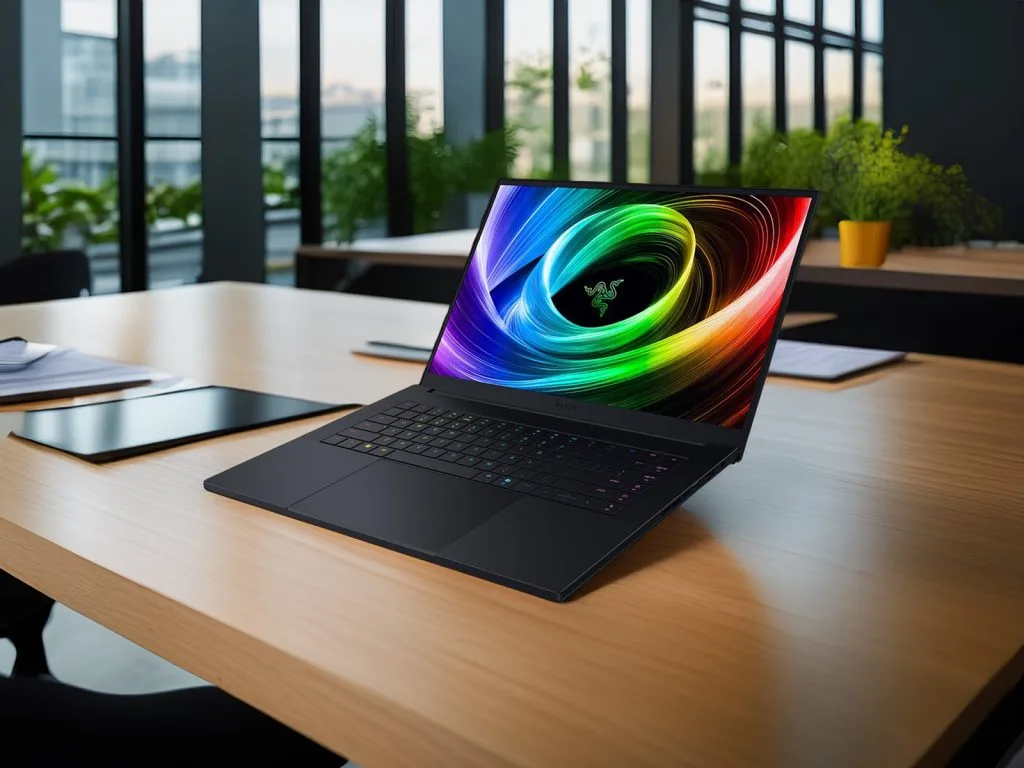The gaming laptop market has a new champion with the release of the 2025 Razer Blade 16 featuring NVIDIA’s latest RTX 5090 mobile GPU.
This premium machine combines cutting-edge technology with Razer’s signature sleek design but commands a hefty $4,900 USD price tag.
I’ve spent some time testing this powerhouse to determine if its performance justifies the premium.
Design and Build Quality
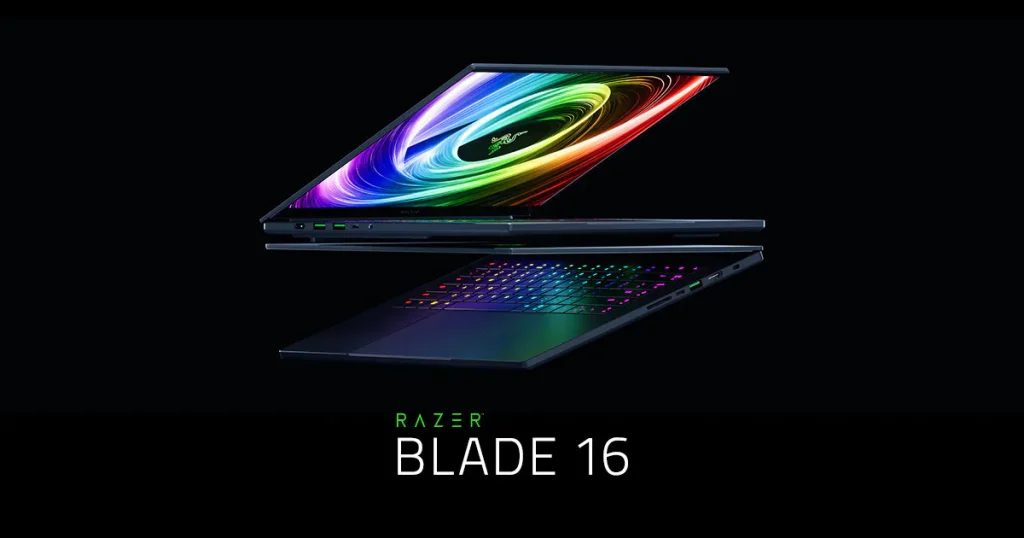
The 2025 Razer Blade 16 continues the company’s tradition of premium construction with its signature CNC-milled aluminum chassis and anodized matte black finish.
What sets this year’s model apart is its significantly reduced footprint compared to the 2024 version.
The laptop is 30% smaller than last year’s Blade 16, measuring just 14.9mm at its thinnest point and 17.4mm at its thickest.
Holding it, the build quality feels as exceptional as ever – that cool, solid aluminum is pure Razer. Even though it’s noticeably thinner this year, there’s barely any flex when you pick it up, which is reassuring.
Weighing in at just 4.71 lbs (2.1kg), this is one of the lightest 16-inch high-performance gaming laptops available, making it 15% lighter than last year’s model.

For comparison, competitors like the ASUS Zephyrus G16 are slightly lighter, but the Blade 16 remains impressively portable for its performance class.
The laptop comes with a 280W power adapter that brings the total travel weight to 6.4 lbs (2.9kg).
The iconic Razer logo adorns the lid with its subtle green glow, maintaining an understated yet premium aesthetic that’s suitable for both gaming and professional environments.
Keyboard and Touchpad
The keyboard receives a significant upgrade this year with 1.5mm of key travel, which Razer claims is 50% more than previous models.
This enhanced travel depth provides a more satisfying typing experience and addresses one of the common criticisms of earlier Blade keyboards.
Razer has added five programmable macro keys on the far right side, offering additional customization options for both gaming and productivity workflows.
I’ll admit, my muscle memory fought those new macro keys on the right at first – I definitely hit the top one instead of Enter more than once! It took about a day of use before it felt natural.
The keyboard features dual lighting, so when you hold the shift or function keys, a secondary light shows which keys can be interacted with.
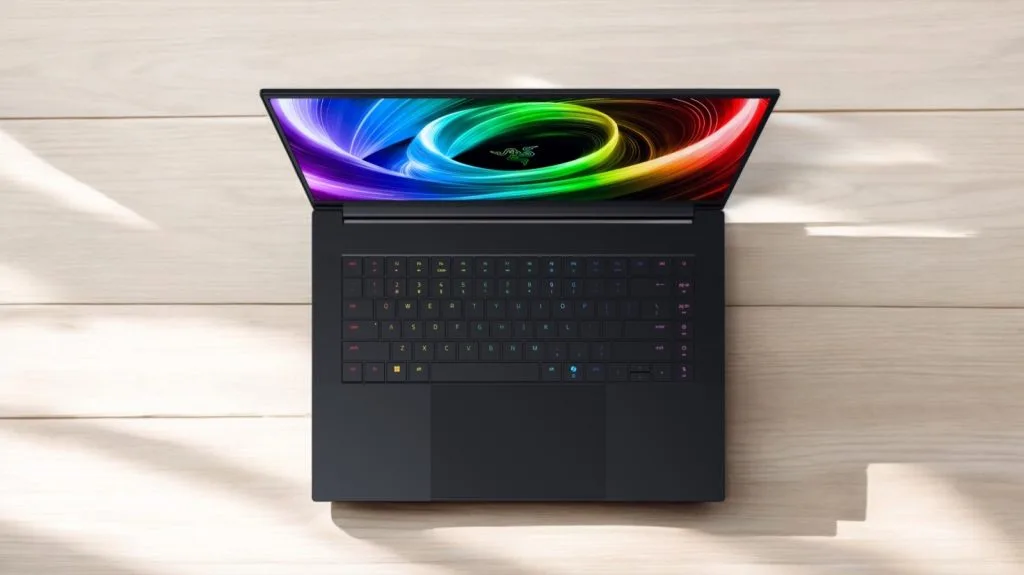
The power button remains close to delete and backspace, but requires a longer press to activate, reducing accidental triggers.
The per-key RGB lighting remains one of the most impressive implementations in any high-end gaming laptop, with 11 different lighting effects available through Razer’s Synapse software.
The keyboard has 17 different brightness levels in 6% increments when using the function shortcuts, which some might find excessive.
Touchpad Improvements
Even though it’s a bit narrower this year, the glass touchpad still feels huge and silky smooth under the fingers.
I really like that you can click anywhere, and the tactile feedback feels crisp and definite.
Palm rejection works well in most scenarios, though some users report occasional issues during intense gaming where palms might barely touch the corner of the touchpad.
The touchpad is positioned well to minimize accidental touches during typing, though as with most gaming laptops, a dedicated mouse is recommended for gaming.
Ports and Connectivity
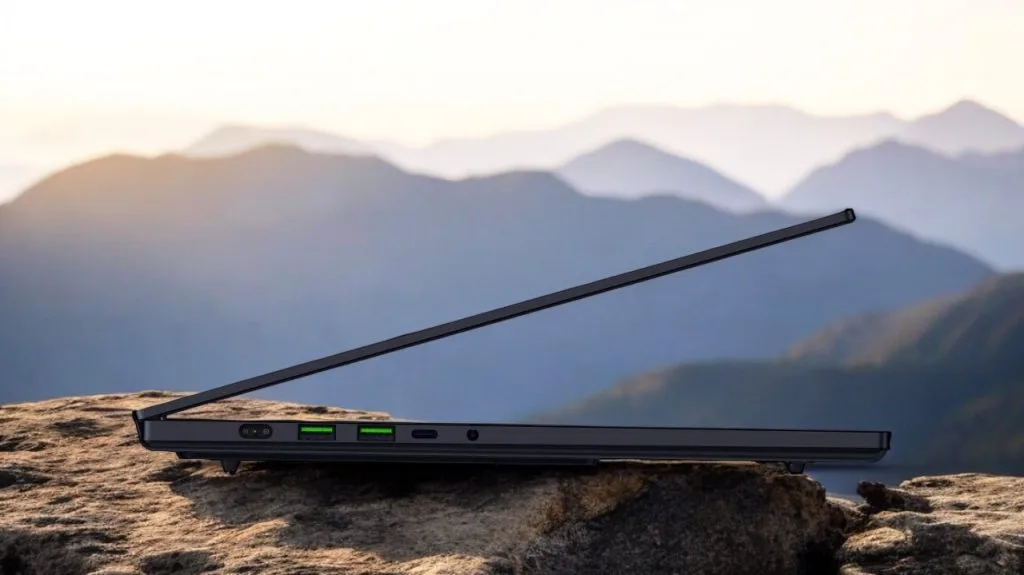
Despite the slimmer profile, the Blade 16 maintains an excellent selection of ports:
- Left side: Power input, 2x USB 3.2 Gen 2 Type-A, USB 4 Type-C, 3.5mm audio combo jack
- Right side: UHS-II SD card reader, USB 4 Type-C, USB 3.2 Gen 2 Type-A, HDMI 2.1
Card Reader and Wireless
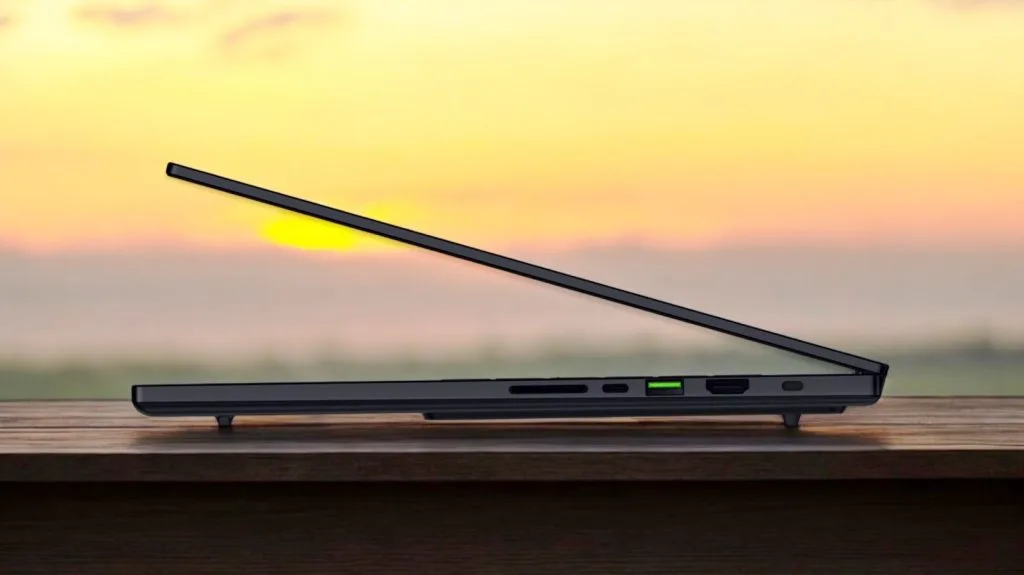
Both USB-C ports support charging up to 100W with compatible chargers.
The UHS-II SD card reader delivers excellent transfer speeds, making this laptop particularly appealing for content creators.
Wireless connectivity is handled by the latest Wi-Fi 7 standard paired with Bluetooth 5.4.
Display Quality
The QHD+ (2560 x 1600) 240Hz OLED display is a standout feature of the Razer Blade 16.
Honestly, firing up a game or watching HDR content on this OLED for the first time is a bit of a ‘wow’ moment. The perfect blacks and ridiculously vibrant colors make everything pop in a way that even top-tier IPS panels can’t quite capture.
Color Accuracy and Brightness
The Delta E values are excellent out of the box thanks to factory calibration, with color gamut coverage that’s among the best in the industry.
This makes the laptop suitable for color-critical work without additional adjustment, a significant advantage for creative professionals.
Brightness peaks at around 400 nits, which is consistent with most OLED panels but may struggle in very bright environments due to the glossy finish.
HDR content looks excellent on this display, with a slight boost over the standard brightness when HDR is enabled.
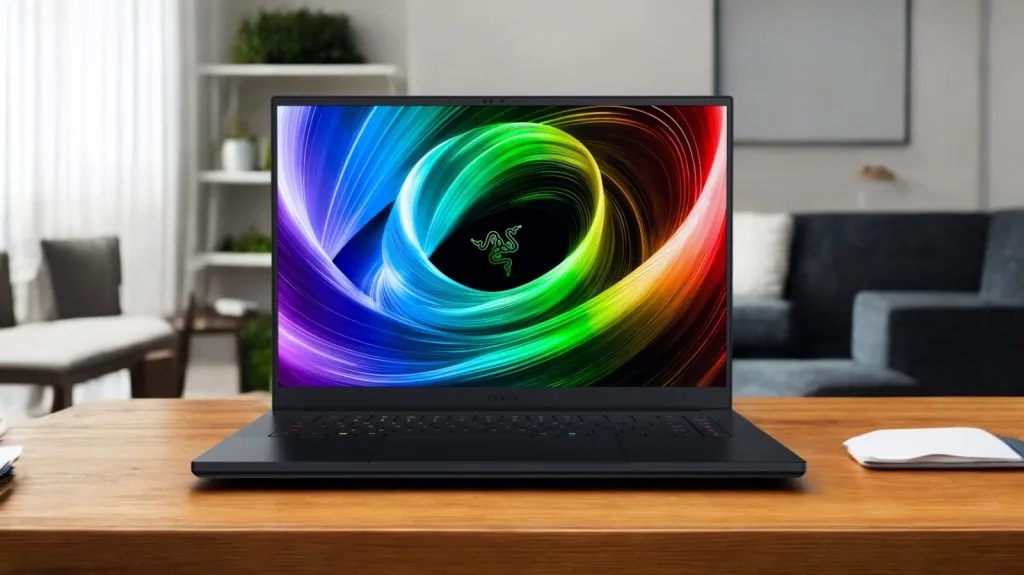
The infinite contrast ratio creates stunning visual depth that IPS and even most Mini-LED panels cannot match.
Response Time and Gaming Performance
Response times are phenomenal at less than half a millisecond.
This makes it one of the fastest displays available on any laptop and ideal for competitive gaming.
The 16:10 aspect ratio provides extra vertical screen real estate compared to traditional 16:9 displays.
Audio System
Razer has upgraded the audio to six speakers, up from four in last year’s model.
Two front-facing speakers complement the rest positioned underneath the chassis.
Sound Quality
The upgrade to six speakers makes a real difference – dialogue in movies felt clearer, and there’s a bit more oomph in the bass compared to last year’s model.
They still don’t have that MacBook richness, but for built-in speakers on a gaming machine, I was pleasantly surprised.
The laptop includes THX Spatial Audio for an enhanced virtual surround sound experience when gaming with headphones.
Performance
AMD Ryzen AI 9 HX 370 Processor
In a significant departure from previous models, the 2025 Blade 16 switches from Intel to AMD.
The Ryzen AI 9 HX 370 is based on the Zen 5 architecture with 12 cores and 24 threads.
This CPU offers solid multi-threaded performance while being more power-efficient than comparable Intel alternatives.
The processor runs at a base clock of 3.3GHz and can boost up to 5.1GHz when thermal conditions permit.
Benchmark Results
In Cinebench R23, the Ryzen AI 9 HX 370 delivers impressive single-core performance.
Multi-core results are competitive but not class-leading compared to thicker laptops with higher-wattage Intel CPUs.
Power Management
The processor’s power limit can be adjusted between 45W and 95W through Razer’s Synapse software.
In practice, it often runs at lower wattages when the GPU is fully loaded.
This power balancing is necessary in such a slim chassis.
When power is prioritized to the CPU in Custom mode, all-core clock speeds can reach nearly 3GHz.
In balanced scenarios, they hover around 2.6GHz.
RTX 5090 Mobile GPU Performance
The headline feature is undoubtedly the NVIDIA GeForce RTX 5090 with 24GB of GDDR7 VRAM.
This makes it the most powerful mobile graphics card currently available.
The standard TGP is 155W, though this can increase to 175W when using Razer’s optional laptop cooler accessory.
Synthetic Benchmarks
In synthetic benchmarks, the RTX 5090 shows a modest improvement over its predecessor.
3DMark Time Spy results are approximately 4-7% higher than the RTX 4090 in last year’s Blade 16.
The newer Steel Nomad benchmark shows more promising results.
It delivers a 13% improvement over the RTX 4090 at 155W and even higher gains at 175W.
Gaming Benchmarks
Okay, benchmarks are one thing, but how does it feel to game on?
Performance really depended on the title, but generally, the RTX 5090 delivered buttery-smooth gameplay at the native QHD+ resolution in most modern games I tried:
AAA Gaming Performance
Cyberpunk 2077 (Ultra settings): The Blade 16 with RTX 5090 delivers around 94 FPS at QHD+ resolution when using the 175W cooler configuration.
This is approximately 10% faster than last year’s model with the RTX 4090, though the improvement is surprisingly modest for a generational leap.
When enabling Multi-Frame Generation, the performance jumps dramatically from around 55 FPS to over 120 FPS with moderate visual artifacts.
Control (High settings): Performance is similar to RTX 4090 laptops in terms of average FPS, showing minimal generational improvement in pure rasterization.
However, 1% lows are notably better, providing a smoother overall experience with fewer stutters or frame drops.
Black Myth: Wukong (High settings): The RTX 5090 shows a 33% improvement over the previous generation, making it one of the better performing titles on the new hardware.
It hits 77 FPS compared to 58 FPS on the 4090 model, providing a much smoother gameplay experience in this demanding title.
Avatar: Frontiers of Pandora shows inconsistent results with the RTX 5090 model actually performing worse in some tests, delivering around 70-73 FPS compared to 106 FPS on the 4090 model.
Racing and Open-World Games
F1 24 (Ultra High settings): At 175W with the external cooler, the Blade 16 achieved an impressive 198 FPS, demonstrating a substantial improvement.
This compares favorably to around 167-169 FPS on 4090 laptops, representing one of the larger performance gains we see across games.
At the standard 155W power level, the performance drops to around 78 FPS, showing how critical thermal and power management is for these high-end components.
Hogwarts Legacy (Ultra settings): With certain settings combinations, the 5090 can deliver up to 65% better performance than the 4090, though this claim has been disputed by some reviewers.
This varies considerably based on specific scenes and settings, and may be influenced by factors beyond just the GPU.
Alan Wake 2 (High settings with ray tracing): The average FPS shows a modest 9% increase at QHD+ but jumps more significantly at higher resolutions.
However, 1% lows are up to 40% better, resulting in a much more consistent experience with fewer jarring drops in frame rate.
Shadow of the Tomb Raider results were mixed, with the RTX 5090 showing a performance deficit at QHD+ (147 FPS vs 165 FPS on the Strix SCAR with 4090) but slightly better results at 4K resolution.
Dirt 5 showed similar behavior with modest gains that couldn’t justify the generational leap in hardware or price.
DLSS and AI Performance
While raw rasterization performance shows moderate gains, the RTX 5090 truly shines when leveraging DLSS technology.
DLSS 4 Improvements
The latest DLSS 4 implementation delivers exceptional upscaling quality that’s often indistinguishable from native resolution.
Frame generation technology provides substantial FPS boosts in supported titles.
Cyberpunk 2077 jumps from around 55 FPS to over 120 FPS with Multi-Frame Generation enabled.
For competitive titles like Marvel Rivals, frame generation can push framerates from 90 FPS to over 250 FPS.
This comes with some increased latency (50-55ms vs 30ms).
Content Creation Performance
The RTX 5090 with its massive 24GB of GDDR7 VRAM makes this Blade 16 compelling for content creators who need portable workstation performance.
The 8GB increase over last generation’s 16GB buffer is particularly valuable for complex projects and higher resolution media.
Video Editing
In Premiere Pro, scrubbing through 4K timelines felt noticeably smoother, and export times saw a small but welcome speed boost – roughly 7% faster than the already capable 4090 model in my tests.
This improvement comes primarily from the three 9th-gen encoders in the RTX 5090 (up from two in the 4090).
DaVinci Resolve render tests show even more significant gains.
The 5090 completes renders about a minute faster than the previous model.
3D and Creative Applications
3D artists will appreciate the approximately 7% performance uplift in applications like Blender.
This improvement is consistent when compared to both the Blade 16 and Strix Scar 18 with RTX 4090.
The massive 24GB VRAM buffer is particularly beneficial for working with high-resolution footage or complex 3D scenes.
It prevents stuttering during video editing preview playback, which was an issue with the previous generation’s 16GB limit.
Thermal Performance
Cooling System
Despite its slimmer profile, the Razer Blade 16 maintains reasonable thermal performance.
The cooling system uses dual fans with a vapor chamber design.
Internal temperatures during combined CPU and GPU stress tests typically remain below 80°C.
This is impressive considering the power-dense components in such a thin chassis.
Surface Temperatures
Keyboard surface temperatures are well-managed during gaming sessions.
Even when pushing the hardware hard, the keyboard deck didn’t get uncomfortably hot.
Sure, the middle section gets noticeably warm (mid-40s Celsius), but my palms rested easy, and crucially, the WASD keys stayed nice and cool – a small thing that makes a big difference during long gaming stints.
Fan Noise
Under load in Performance mode, you’ll definitely hear the fans spin up, but it’s more of a lower-pitched ‘whoosh’ than a high-pitched whine. For me, it wasn’t distracting during gaming, especially with headphones on.
The fans are silent at idle, which is excellent for productivity work in quiet environments.
Maxing out the fans for better cooling does produce a more substantial noise profile that some might find distracting.
Using an external cooling pad at higher RPM creates significantly more noise than the laptop’s internal fans at maximum speed.
The thermal hood area on the bottom panel provides extra cooling space, a clever design that manages to maintain thermals despite the reduction in chassis size.
Air is exhausted down and out the back, avoiding hot air blowing on your mouse hand during intense gaming sessions.
Upgradability
Internal Access
The Razer Blade 16 can be opened by removing ten TR5 screws.
This provides access to some upgradable components.
Memory Limitations
The biggest limitation is the soldered RAM.
You cannot upgrade the memory after purchase – a consequence of using the faster LPDDR5X-8000 memory.
Storage Options
Storage is upgradable with two M.2 PCIe Gen 4 slots.
Both slots can accommodate thick 4TB drives with components on both sides.
This is an improvement over last year’s model, which had stacked M.2 slots that limited thickness options.
The Wi-Fi card is replaceable, allowing for potential future upgrades as wireless standards evolve.
Razer’s battery health optimizer in the Synapse software can limit the maximum charge level between 50% and 80%.
This feature helps extend battery longevity.
Battery Life
Battery Capacity and Charging
The Blade 16 houses a 90Wh battery, slightly smaller than the 95Wh battery found in last year’s model.
Despite the smaller capacity, battery life has improved by approximately 22% compared to the previous generation.
This improvement comes from the more efficient AMD processor.
The included 280W charger is required for full performance.
The laptop can also charge via USB-C at up to 100W with compatible chargers.
Razer claims 50% charge in 30 minutes and 80% in 48 minutes with the included charger.
Battery Performance
I was genuinely impressed to squeeze around 8 hours of regular web Browse and document work out of the battery – that’s a solid improvement, likely thanks to the efficient AMD chip.
It won’t win any awards against a MacBook, but for a powerful gaming rig like this, it’s enough freedom to leave the charger behind for a good chunk of the day.
The improvement comes primarily from the AMD processor’s greater efficiency compared to last year’s Intel chip.
Gaming on battery power is possible but limited, as expected with such power-hungry components.
You’ll get about 1 hour and 26 minutes of runtime in less demanding titles using NVIDIA’s Battery Boost technology, which is typical for this class of machine.
The laptop’s “battery refresh rate” feature automatically drops the screen from 240Hz to 60Hz when unplugged, which helps extend runtime.
Users can manually toggle between these refresh rates using the Function + R shortcut at any time.
Software Experience
Operating System
The Razer Blade 16 comes with a relatively clean Windows 11 installation.
It’s refreshingly free from excessive bloatware.
Razer Synapse
Razer’s Synapse software serves as the central hub for controlling performance modes, keyboard lighting, and fan curves.
The software offers four performance modes: Silent, Balanced, Performance, and Custom.
Each mode offers different power allocations for the CPU and GPU.
Custom mode allows more granular control over CPU power limits (between 45W and 95W).
It even enables CPU undervolting for potentially better efficiency.
Graphics Switching
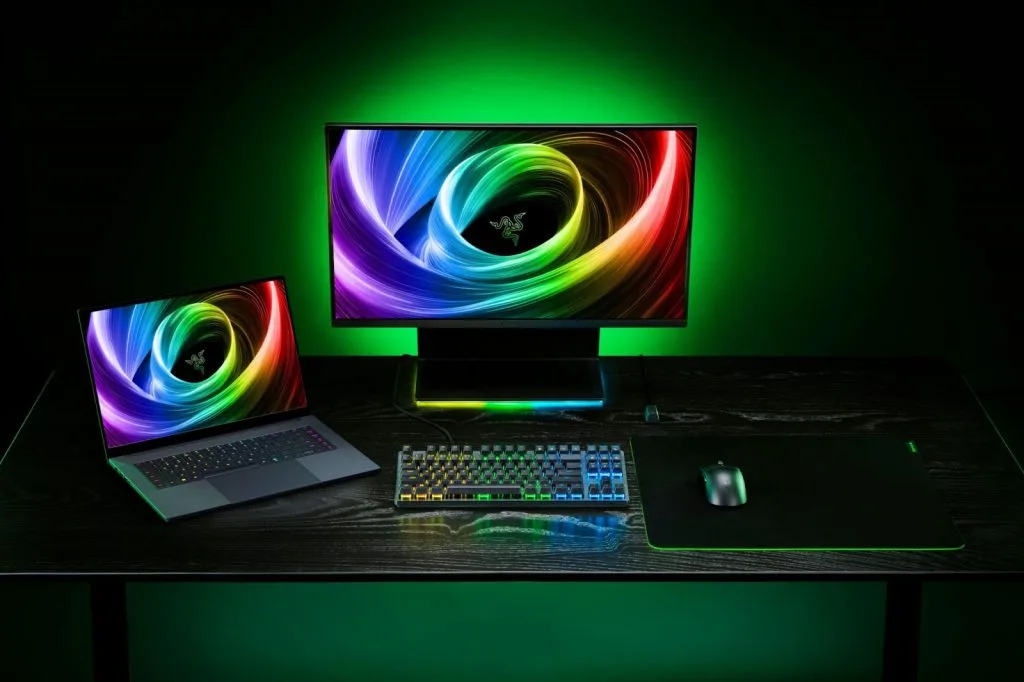
Advanced Optimus is supported, allowing seamless switching between the integrated Radeon 880M graphics and discrete RTX 5090.
This switching happens without requiring a system restart.
G-Sync is available when Optimus is disabled.
FreeSync works with the integrated graphics when Optimus is enabled.
Pros and Cons
Pros
- Premium build quality with a significantly thinner and lighter design
- Gorgeous QHD+ 240Hz OLED display with excellent color accuracy
- Improved keyboard with better key travel and additional macro keys
- Powerful RTX 5090 GPU with 24GB VRAM for gaming and creative workloads
- Excellent port selection including dual USB-C/USB-A on both sides
- Improved battery life despite the thinner design
- Better speakers than previous generations
- High-speed UHS-II SD card reader for content creators
- Wi-Fi 7 and Bluetooth 5.4 for future-proof connectivity
Cons
- Extremely high price point of $4,900 USD
- Non-upgradeable RAM due to soldered design
- Performance gains over previous generation GPUs vary considerably by application
- Glossy screen can cause reflections in bright environments
- CPU performance limited to maintain thermal balance in thin chassis
- Maximum GPU power requires additional cooling accessory
- Battery still smaller than some competitors
Who Should Buy This Laptop?
Ideal User Profiles
The Razer Blade 16 with RTX 5090 is ideal for users who prioritize premium build quality and powerful performance in a thin package.
Content creators who work with high-resolution video or complex 3D scenes will benefit from the large VRAM buffer.
Gamers who want a premium experience with support for high refresh rates at QHD+ resolution in modern titles.
Professionals who need a powerful workstation that doesn’t look out of place in corporate environments.
Users who can afford the premium price tag and want the latest technology in a sleek, well-built package.
Who Should Look Elsewhere
Budget-conscious consumers will find much better value in less expensive gaming laptops with slightly lower specs.
Those who prioritize raw performance over portability would be better served by thicker machines with better cooling.
Users who need upgradeable RAM for future-proofing should look elsewhere.
Gamers who primarily play competitive titles at lower settings may not need the power of an RTX 5090.
Those who need extremely long battery life for all-day use without access to power outlets.
AI Capabilities
Neural Processing
The RTX 5090 with its enhanced AI processing capabilities makes this laptop suitable for on-device AI workloads.
The updated Tensor cores provide significant improvements for AI image generation tasks.
Local diffusion models run more efficiently on this hardware.
Graphics AI
DLSS 4 leverages these AI capabilities to deliver impressive upscaling quality with minimal performance impact.
Multi-Frame Generation can boost framerates dramatically in supported titles.
The 24GB VRAM buffer is particularly beneficial for running larger AI models locally.
This prevents constant swapping to system memory, which can cause stuttering.
The AMD processor includes dedicated NPU hardware for AI acceleration.
This complements the GPU’s capabilities for certain workloads.
Comparison with Alternatives
Similar Thin Gaming Laptops
The most direct competitor, the ASUS ROG Zephyrus G16, offers similar specifications with RTX 5090 graphics in a portable form factor.
However, it tends to have a lower TGP rating of around 100W with dynamic boost to 120W, which limits its gaming performance compared to the Blade 16.
Interestingly, the Zephyrus G16 with RTX 5090 is actually more expensive than the equivalently specced Blade 16 in some markets, making the Razer a comparatively better value despite its high price.
The MSI Stealth 16 provides another thin option with high-end components for those seeking portability with power.
It typically runs its GPU at around 115W, potentially limiting performance compared to the Blade’s 155W (or 175W with cooler) power target.
The Lenovo Legion Slim 7i with 5090 offers another alternative for those who prefer Intel processors but still want a relatively slim profile.
Previous Generation Value
Last year’s Blade 16 with RTX 4090 can be found at lower prices now.
It delivers similar performance in many scenarios, making it potentially better value.
Performance-Focused Alternatives
For those prioritizing performance over portability, larger options exist.
The Lenovo Legion Pro 7i or ASUS ROG Strix SCAR 18 offer higher sustained performance with better cooling systems.
These come in much larger chassis with greater weight.
Non-Windows Options
The MacBook Pro with M4 Max offers comparable creative performance with significantly better battery life.
However, it has limited gaming capabilities compared to Windows gaming laptops.
Frequently Asked Questions
Value and Performance
Is the Razer Blade 16 RTX 5090 worth it?
The Razer Blade 16 with RTX 5090 is worth it if you need powerful yet portable performance and don’t mind the high price.
For most users, models with RTX 5080 or even 4090 offer better value with similar performance.
How fast is the RTX 5090 laptop GPU?
The RTX 5090 laptop GPU delivers approximately 5-15% better performance than the RTX 4090 in rasterized rendering.
Larger gains appear when utilizing DLSS 4 and at higher resolutions where the extra VRAM becomes beneficial.
Razer Blade 16 5090 vs 4090 gaming performance?
Gaming performance varies by title, with the RTX 5090 delivering approximately 5-15% better performance than the RTX 4090 in most games at native resolution.
The gap widens at 4K resolution and when using DLSS features.
Games like Black Myth: Wukong show greater improvements of up to 33%.
How much does the Razer Blade 16 5090 cost?
The Razer Blade 16 with RTX 5090 is priced at $4,900 USD for the configuration with 32GB RAM and 2TB SSD.
Lower configurations with RTX 5070 Ti or RTX 5080 start at around $3,000 USD.
This represents a $200 price increase over the comparable 2024 model at launch.
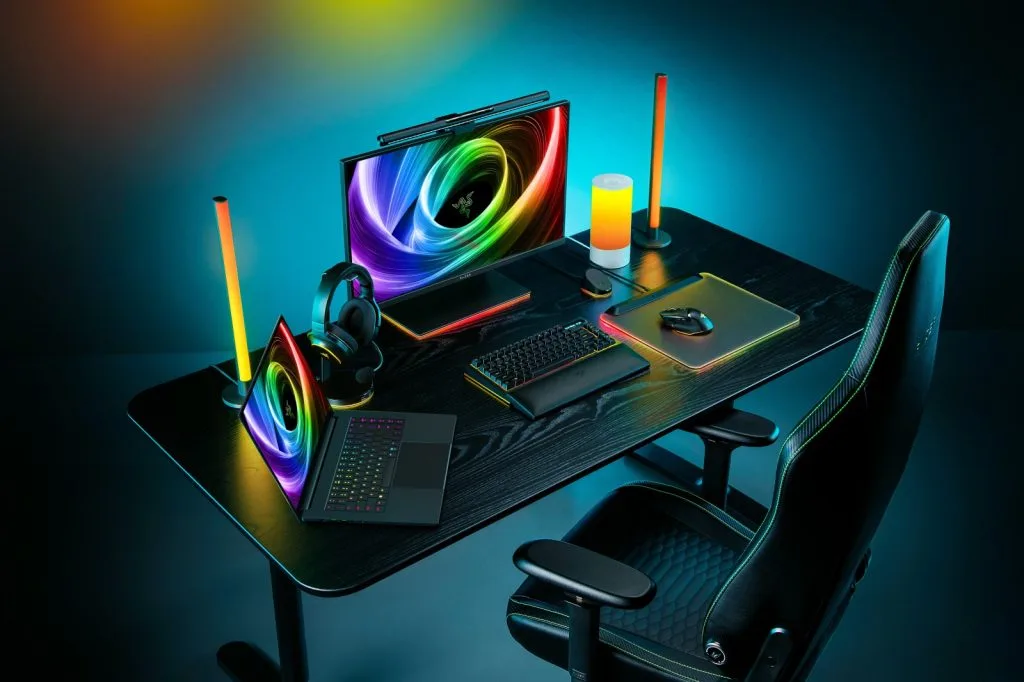
Thermal and Usage Questions
Does the Razer Blade 16 2025 overheat?
The Razer Blade 16 2025 maintains reasonable temperatures despite its thin design.
Internal components typically stay below 80°C during intense workloads.
The surface gets warm particularly in the center keyboard area (mid-40s°C) but not uncomfortably hot.
What is the battery life of Razer Blade 16 5090?
The Razer Blade 16 with RTX 5090 offers around 8 hours of battery life for general productivity tasks.
Gaming on battery power is limited to about 1 hour and 20 minutes with Battery Boost technology.
The battery refresh rate feature automatically lowers to 60Hz when unplugged to extend runtime.
How loud is the Razer Blade 16 2025?
The Razer Blade 16 2025 produces moderate fan noise during intensive tasks.
It’s not excessively loud in standard performance modes.
Maximum fan speeds are significantly louder but rarely needed for typical workloads.
Technical Features
Can you upgrade RAM on Razer Blade 16 2025?
No, the RAM on the Razer Blade 16 2025 is soldered to the motherboard and cannot be upgraded after purchase.
This design enables faster LPDDR5X-8000 memory but eliminates future upgrade potential.
Most competitors using the same AMD Ryzen AI 9 HX 370 processor also have non-upgradeable RAM.
What CPU is in the new Razer Blade 16?
The new Razer Blade 16 features the AMD Ryzen AI 9 HX 370 processor.
This 12-core/24-thread CPU uses the Zen 5 architecture with a base clock of 3.3GHz and boost clock up to 5.1GHz.
The processor includes integrated Radeon 880M graphics that help with power efficiency when not gaming.
Is DLSS 4 good on laptops?
DLSS 4 works exceptionally well on laptops, providing significant performance improvements with minimal visual quality loss.
For power-constrained systems like gaming laptops, it’s practically essential for high framerates at higher resolutions.
What is Nvidia Battery Boost 2.0?
NVIDIA Battery Boost 2.0 intelligently manages GPU performance when gaming on battery power.
It dynamically adjusts framerates based on gameplay demands, providing higher FPS during active gameplay.
The system reduces framerates during less intensive moments like cutscenes or when browsing in-game menus to extend battery life.
Is Razer Blade 16 good for video editing?
Yes, the Razer Blade 16 with RTX 5090 is excellent for video editing.
It offers powerful performance, a color-accurate OLED display, and 24GB of VRAM.
The improved encoders (three 9th-gen vs two in RTX 4090) enhance rendering speeds by approximately 7-10% in applications like Premiere Pro.
Conclusion
The 2025 Razer Blade 16 with RTX 5090 represents an impressive engineering achievement.
It packs tremendous power into a significantly thinner and lighter chassis than its predecessor.
The switch to AMD’s Ryzen AI 9 HX 370 processor enables better battery life and thermal management.
This comes with some compromise in raw CPU performance compared to high-wattage Intel alternatives.
The RTX 5090 delivers modest but meaningful performance improvements over the previous generation.
These gains are particularly noticeable when utilizing DLSS and at higher resolutions.
The main drawback remains the extraordinarily high price tag of $4,900 USD.
This puts the laptop firmly in the premium category and out of reach for most consumers.
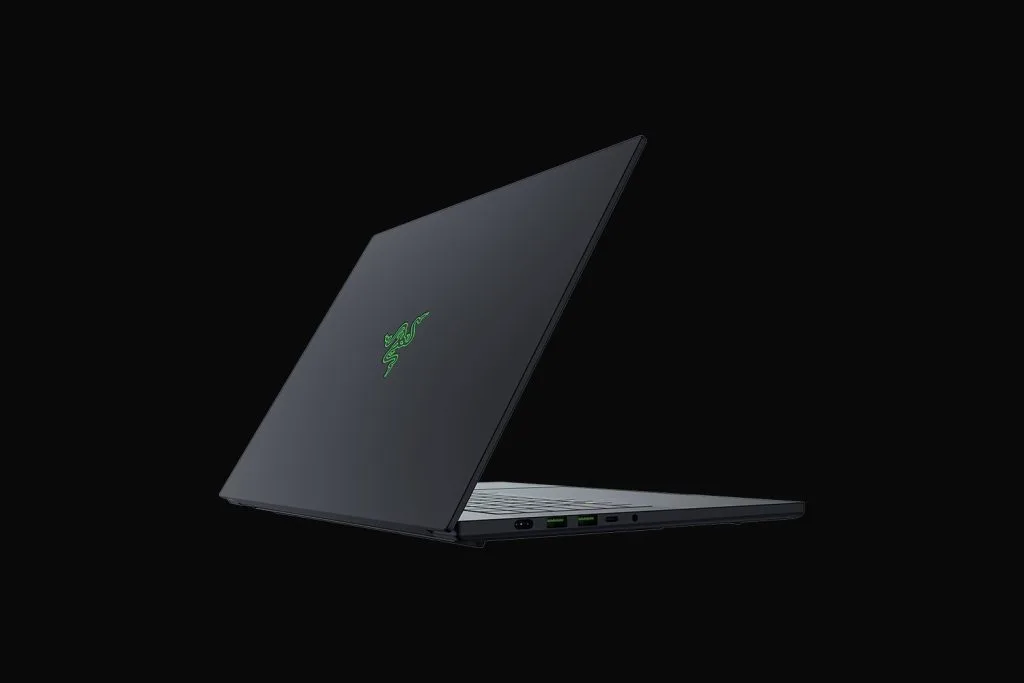
For those who can afford it and value the combination of power and portability, the Razer Blade 16 offers one of the most premium Windows laptop experiences available today.
However, price-conscious shoppers should consider alternatives like the RTX 5070 Ti version or even last year’s models with RTX 4090/4080 graphics.
Ultimately, the 2025 Razer Blade 16 successfully delivers on its promise of premium design and high performance.
Whether it’s worth the substantial investment will depend entirely on your specific needs and budget.


